Story
Tamil Nadu | MyQuest 21st Century Educator Awards
In a first of its kind for us, this award recognizes innovative pedagogical approaches by Employability Skills (ES) trainers part of the Industrial Training Institute ecosystem who have played a key role in preparing young people for the future of work.
Details
The MyQuest 21st Century Educator Awards is presented in collaboration with the Departments of Employability and Training (DET) for Assam, Gujarat and Tamil Nadu respectively, with support from Cisco India. This February, we've completed a virtual award ceremony for trainers in Tamil Nadu. The award ceremonies for Assam and Gujarat are scheduled to happen soon.
Tamil Nadu
The 10 awardees are Thabitha V., Gopinath C., Sharadha U., Karthikeyan A., A. Vairamani, Rathika L., Livingston Gnana Selvin S., Stella Mary S., Belwin Joel S., and Sakthivel P.
TRANSFORMING LEARNERS
Stella Mary S., Govt. ITI - Thindivanam
Stella Mary made her foray into teaching just a year ago. Initially, she was very apprehensive about managing a class. “I don’t have a very loud voice and speak very softly, so I would worry if students could follow the concepts I was trying to explain,” she says. But over the course of a couple of months, she managed to befriend students and overcome her fears.
She realized very early on that she had to build a relationship with the students for her to be able to motivate them to learn the employability skills curriculum -- the students never had an ES trainer before and didn't know how this subject would help them. “When I was in college, If a teacher was very strict, we stayed away from the teacher. We wouldn’t ask any doubts and try to avoid the teacher as far as possible”, says Stella. She didn’t want the same to happen to her and therefore gradually tried to build a rapport with students based on mutual respect.
Students were hesitant to speak up in class and failed at simple exercises like providing a self-introduction. English wasn't their first language, they were more comfortable with the vernacular language. To help students become self-aware she asked them to write down their strengths and weaknesses. Then, with the help of the student, she built a plan to help them address their weaknesses and enhance their strengths. Students were given a certain amount of time to try the plan out. “After a couple of months, students noticed significant changes in their ability to overcome their weaknesses,” she adds. Students were then asked to share their progress in class, which further increased their self-confidence.

Group discussions also helped students engage in her class. Both senior and junior students were grouped together to discuss about a host of different issues from pop culture, politics, and their favourite sports icons. The senior students also got an opportunity to allay any fears that the juniors had about their trade or examinations.
Owing to the pandemic and the lockdown, Stella had to transition to online classes merely three months into her new job as a trainer. “I was just about getting to know the students when suddenly physical classes were no longer possible,” says Stella. She also realized most of the students couldn’t be part of the online classes because of poor connectivity, lack of smartphones, and paucity of time as some of them had started part-time jobs in their neighbourhood to support their families.
“I would make chapter-wise notes on PPT for the class and I soon started uploading these notes onto the WhatsApp groups that I had created with each batch,” she adds. She claims that while this didn’t ensure learning, it did provide trainees a ready reference for learning on their own.
Stella is a huge believer in self-learning and encouraged students to approach her with doubts or if she were not available then use the internet to try and understand concepts of employability skills on their own. “Students not only used the internet for ES-related concepts but also began using it for their trade-related queries,” she adds. Stella hopes to continue to inculcate self-learning amongst students and inspire them to develop key 21st century skills through her new pedagogical approaches.
INNOVATING FOR CHANGE
Belwin Joel S., Govt. ITI - Vepalodai
Belwin Joel is a post graduate in Engineering and Management studies. He started his career as an assistant professor at an engineering institute. “I came across this Govt. ITI in Vepalodai which despite being in a rural area had state-of-the-art teaching equipment like smart boards (electronic interactive white boards) and a computer lab. I wanted to be part of this ITI and work towards transforming the lives of young people,” he says.
Luckily for Belwin, an opportunity arose in 2016 and he joined as an Employability Skills (ES) Instructor in the very same ITI. Belwin claims that he realized soon enough that his teaching approach had to be drastically different for ITI students. “I felt I needed the students to consider me as one amongst them. In order to win their confidence, I opened up to the students about my own life and spoke to them about experiences and challenges of my life,” says Belvin.
Belwin believed that a conventional classroom set up where the teacher taught a lesson and students were passive recipients of information did not work for a subject like employability skills. So he focused on activity-based learning and facilitated activities that students could participate in with a sense of camaraderie. He also allowed students to collect motivational quotes and turn them into beautiful artwork displayed all over the class.
Given the communities these students came from, the fear of the English language was ingrained in them. Students struggled with poor vocabulary, so to improve their vocabulary, he bought story books in English and encouraged students to read them out loud in class. “During lunch time I introduced them to the typing software ‘Alagi’, a transliteration software, using which English text is transliterated into Tamil and vice versa,” says Belvin.
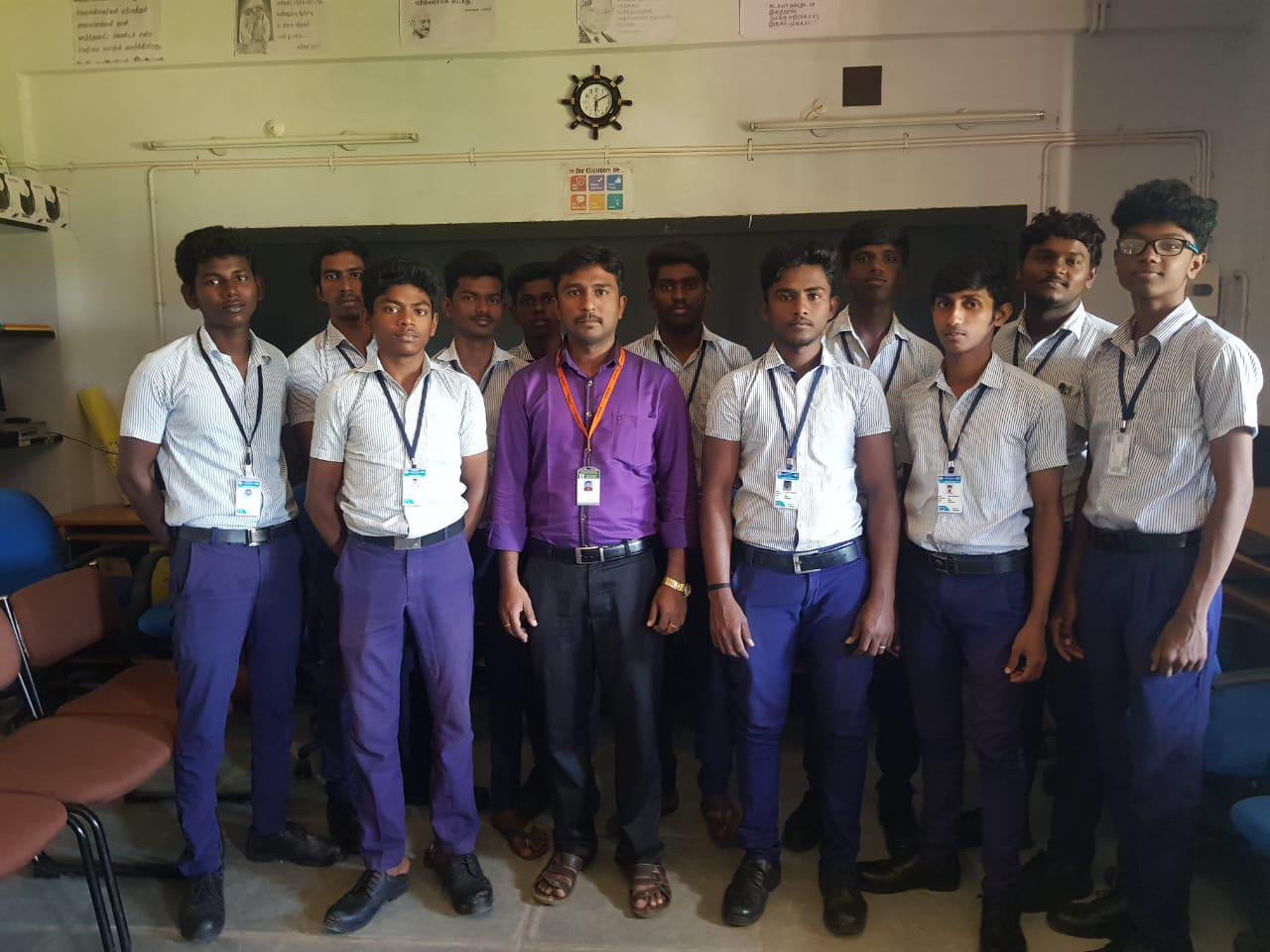
To motivate students to make time for this, he also started awarding students with the highest typing speed. “When students saw their friends proudly showcase their achievements in class they were motivated to come and join the typing sessions during the lunch break,” he adds.
These activities made the ITI very popular amongst other aspiring students in the local communities in and around the ITI. “The word in the villages was that young people could learn to use computers in the ITI. There was a surge in registrations and more number of students signed up to join the ITI,” he adds.
However, despite his successes, Belwin felt that he still sometimes found it hard to control the class. “In some instances, I had to be a little harsh with the students and then they would go back to their shells,” he adds. But a little support and new techniques taught him how to gauge the mood of the class and introduce an activity to ensure students continued to remain focused in class.
He met other ES trainers from across Tamil Nadu and it gave him an opportunity to talk to them about the issues he faced in class. He realized that he wasn't the only one and there were others like me, who were also innovating and finding new ways of engaging their class,” he adds.
Understanding blended learning and using a combination of technology and activity-based learning to impart key 21st century skills changed the way he approached employability skills training.
During the pandemic, Belwin used WhatsApp groups extensively to stay in touch with his students. He made short videos and used remote assist apps to help students join an online class.
Belwin plans to continue to support students to learn and build the confidence to find gainful employment. ‘I faced countless challenges during my college days and while attending interviews which I don’t want my students to encounter. I will work towards ensuring that they become confident about their skills and face the world fearlessly,” says Belwin.
BUILDING TRUST BEFORE TRANSFORMATION
Livingston Gnana Selvin S., Govt. ITI - Tiruchendur
Livingston Gnana Selvin S., an MBA, started his career as an Employability Skills (ES) trainer at Govt. ITI Kadayanallur in the year 2015. After a year, he was transferred to Government ITI, Tiruchendur, where he experimented with new pedagogical approaches and transformed the way students learnt in an ITI.
“When I was working as a consultant facilitator in Anna University, Tirunelveli campus; I developed a bond with the students which served me in great stead. When the shift happened from an engineering college to an ITI, I honestly felt my work would be easier but it wasn’t,” says Livingston.
Livingston had to take multiple steps to build a rapport with the students. “After months of trying, students finally began to consider me as one amongst them. They began trusting me and it became easier for me to bring about change in perspectives and behavior,” he adds.
New activities helped Livingston change the way his students interacted with him and each other. He used Q&A in his classroom to ensure that students voiced their opinions. “In an ITI, it is very important to give students an opportunity to express themselves. Most of the students only remember being ignored in school and a place where their voice is heard, gives them confidence,” he adds.
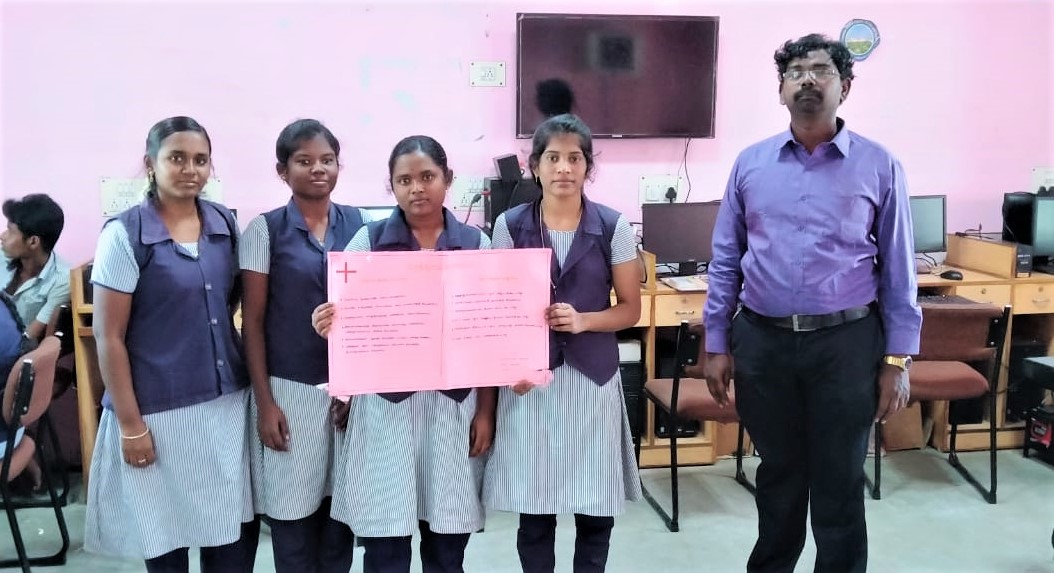
He also used thematic videos to explain concepts in employability skills. Along with videos, he occasionally uses Tamil movie scenes and memes to teach concepts to students. References to Tamil movies increased recall value.
"I knew some of my students were very active on social media, so I also began using social media platforms to reach out to them,” he says about how he shifted to online classes during the pandemic. He used WhatsApp to let students know of upcoming online sessions. But many of his students were left behind due to lack of access or internet connectivity. “Parents also were not supportive. They didn’t believe that students could learn with the aid of mobile phones,” he says.
In order to convince parents and help students get access to a device, Livingston made home visits where he explained to parents how online classes would help and requested them to allow their children to use a device. “In some cases, the parents couldn’t afford a new phone, and I requested them to allow their children to share a device,” says Livingston.
The pandemic was a great learning and helped Livingston understand the challenges that are associated with online learning especially in a country like India where digital access still eludes a large majority.
He did all he could to make sure most of his students got learning material during the lockdown. "I made short notes on my sessions and posted them on the WhatsApp groups. So students who had access to a phone for a very short duration, could quickly go through the posts using low bandwidth and get a summary of the class,” he adds. Amongst other tools, he also used Google Classroom and Google forms to test the students on their learning.
Livingston hopes to continue to support his students to have access to learning and build the key skills required to be ready for the job market. “ My students have enormous flair and I am confident they will do very well in a workplace,” he adds.
MANAGING WITH MEAGRE RESOURCES
Rathika L., Govt. ITI - Viralimalai
Rathika L., a trainer in Pudukkottai district had to reinvent her teaching style to ensure that her students remained attentive in class. A regular classroom setup was not working, as students were easily distracted and could not sustain their attention for the whole duration of the class.
Adopting a blended learning model and using available resources in the ITI, Rathika quickly began using a projector and screen during her sessions. “I could begin my classes with a video on the topic of the day. Video as a medium was very captivating and I noticed a peak in student interaction as they all had opinions about it,” she says.
She would bring the projector out everyday, and use videos and roleplay often to explain concepts related to employability skills. “Students loved role play and because it was their friends or even they themselves, who were part of it, they listened, despite the noise from outside,” says Rathika.
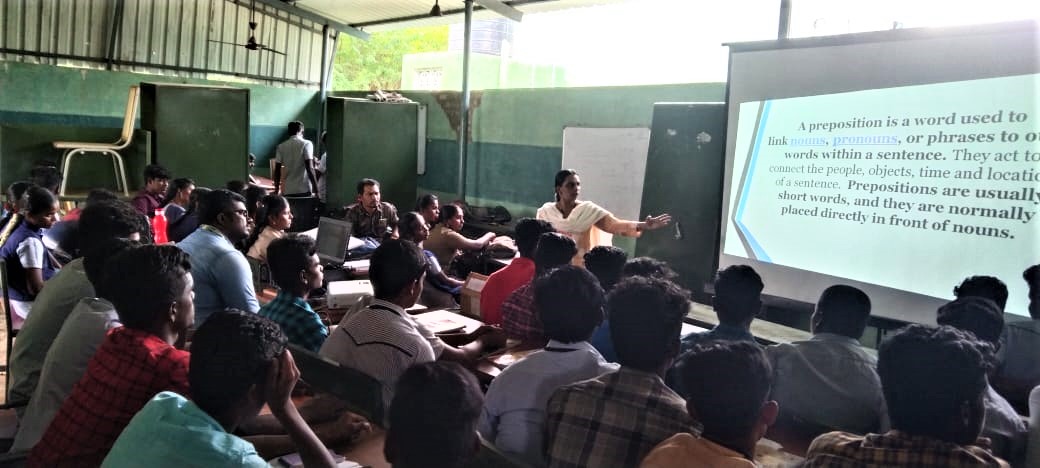
She also credits her student’s enthusiasm for her ability to experiment in class. “They have been supportive. They listen to what I have to say and realize we are working with few resources,” she adds.
Rathika used fairly simple exercises in class to engage students. One of them, which she is very proud of, is newspaper reading. “Most of my students read very little and even if they did read they didn’t understand much. This was especially true of English. So I would take the English and Tamil Newspaper every day to class and pick students to read out the news aloud in class. This not only kept them cued in with the major developments in the country, but also developed their vocabulary,” she adds.
During the pandemic, many of her students did not have access to smartphones or the internet as they lived in remote locations. So she requested students with access to come to a location where even students without access to smartphones or an internet connection could join them.
Rathika hopes to continue to engage her students in small, innovative ways, now that the institutes are open. “There are challenges but I am glad I am able to overcome them with support from the ITI and my students,” she adds.
NURTURING SELF-LEARNERS
Sakthivel P., Govt. ITI - Dharmapuri
Sakthivel P. always wanted to work with young people in rural areas. “I come from a rural background and faced many challenges while pursuing an education. I want to help other rural youth like me find a job and become confident about their abilities,” he says.
In the beginning of his career, Sakthivel would meet each batch only once a week for two hours. But realized that many concepts covered in those two hours would not be remembered or retained by students the week after. So he decided to introduce a structure to his sessions. “In order to get good at anything, there is a need to create a habit. I realized that my class would need to have a certain flow that encourages students to recall what they have learnt in the previous class,” he adds.
Sakthivel’s classes now begin with the review of an assignment he gives at the end of every class. “I tell my students the topic we will be covering next week and ask them to collect as much information about that topic,” he adds. This exercise encourages students to come prepared to a class. He treats learning and teaching as a two-way street and believes it is most effective when both the teacher and the trainer come prepared for a class.
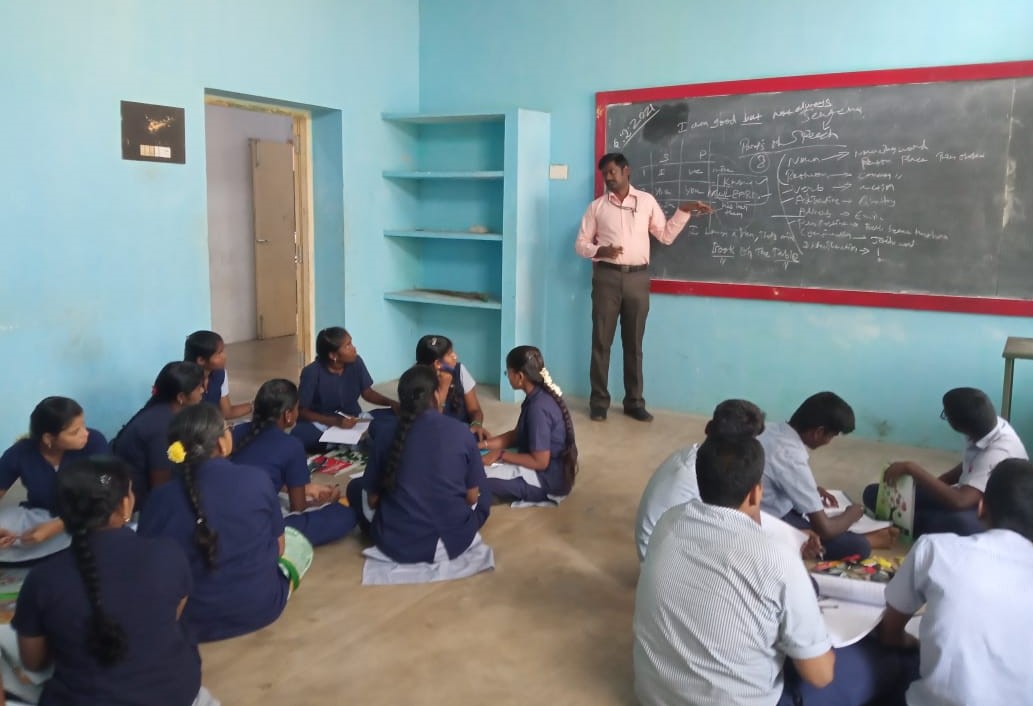
The review process involves three questions, where he asks his students - what do you know?, what do you want to know? And, finally what have you learnt? These three questions help Sakthivel get an idea about the understanding of each student. He also encourages one student in class to recap the previous week’s lessons and asks other students to chip in points that have been missed out. “These are simple techniques but keep the class interactive and help students remember key concepts,” he adds.
The other key challenge he faced was that many of his students despite being very diligent about completing work did not speak up in class. “There was a certain hesitancy. And, when I singled them out they would find it hard to even weave a sentence,” he adds. He soon learnt that the reason for this hesitancy was because of bad experiences with teachers in the past. “When you come from a certain economic background, your parents are busy making a living and in school you just fall off the radar. No one really pays any attention to you or even notices that you might be actually good at something,” says Sakthivel.
He began to reach out students who were not very active and encouraged them to speak, he appreciated them in class and gradually began to see changes in behaviour. “They began answering questions and interacting with other students. It was heartening to see the change,” he says. He understood that it is very important to give students space to express their opinions and talk openly about their challenges.
However, when the pandemic struck, Sakthivel found it very difficult to reach out to his students. “The online medium can become very impersonal. It is not the same as a classroom where you can see the body language of a student and assess their understanding,” he adds.
But, he soon worked his way around a one-way mode of teaching. “I used Google Classroom extensively, where I would upload a PPT every week. Students would reach out to me either on chat box or over the phone with their doubts,” he adds.
Sakthivel continues to support rural youth to build confidence and find jobs. He has over the years built processes in his classroom to ensure that employability skills is imparted effectively. “When you logically think of a problem there is always a way to solve it with a good process. This is true in life and in the classroom,” he says.
PROMOTING EQUITY IN THE CLASSROOM
Thabitha V., Govt. ITI - Guindy
Thabitha V, an Employability Skills (ES) trainer in Guindy, did not have it easy growing up. Her father, a strict disciplinarian, didn't think it was necessary for women to study. So, when she fared poorly in her fifth standard, barely managing to pass, he declared that education was a waste of time for a girl child. Luckily for Thabitha, a relative came to the rescue and enrolled her to the sixth standard at a government school.
This experience of being denied something as basic as education stayed with her. “Prior to this experience, I would just about manage to clear my final exams, but after my father began objecting to my education, I felt this urge to prove him wrong. I started doing well in school. From a student who barely passed, I managed to secure over 80% in all my exams,” she says.
Despite this stark change, there was resistance every step of the way. Her mother, who supported her studies, would stealthily enroll Tabitha in courses and only if her scores were good, would Thabitha's father momentarily appreciate it -- only to suggest that Thabitha had done enough studying. "My 10th STD, 12th STD, graduation and post-graduation was all done in the shadow of fear that if I did not perform, I wouldn’t be allowed to continue any further,” adds Thabitha.
She credits her mother’s encouragement to where she is in life: an MBA and an ES trainer at a Govt. ITI since 2018. Thabitha also credits her personal experience to how she interacts and treats students in her class. She strongly believes every individual -- and student in her class -- is talented in their own way. She says, "I try my level best to treat all my students equally and try to keep each one of them engaged.”
"I realized that I learnt better by listening rather than reading. Similarly, there are students in my class who learn better by doing than by listening", says Thabitha as she talks about how a blended learning model offered her an improved teaching methodology that allowed each student to learn in a way that suited them best.
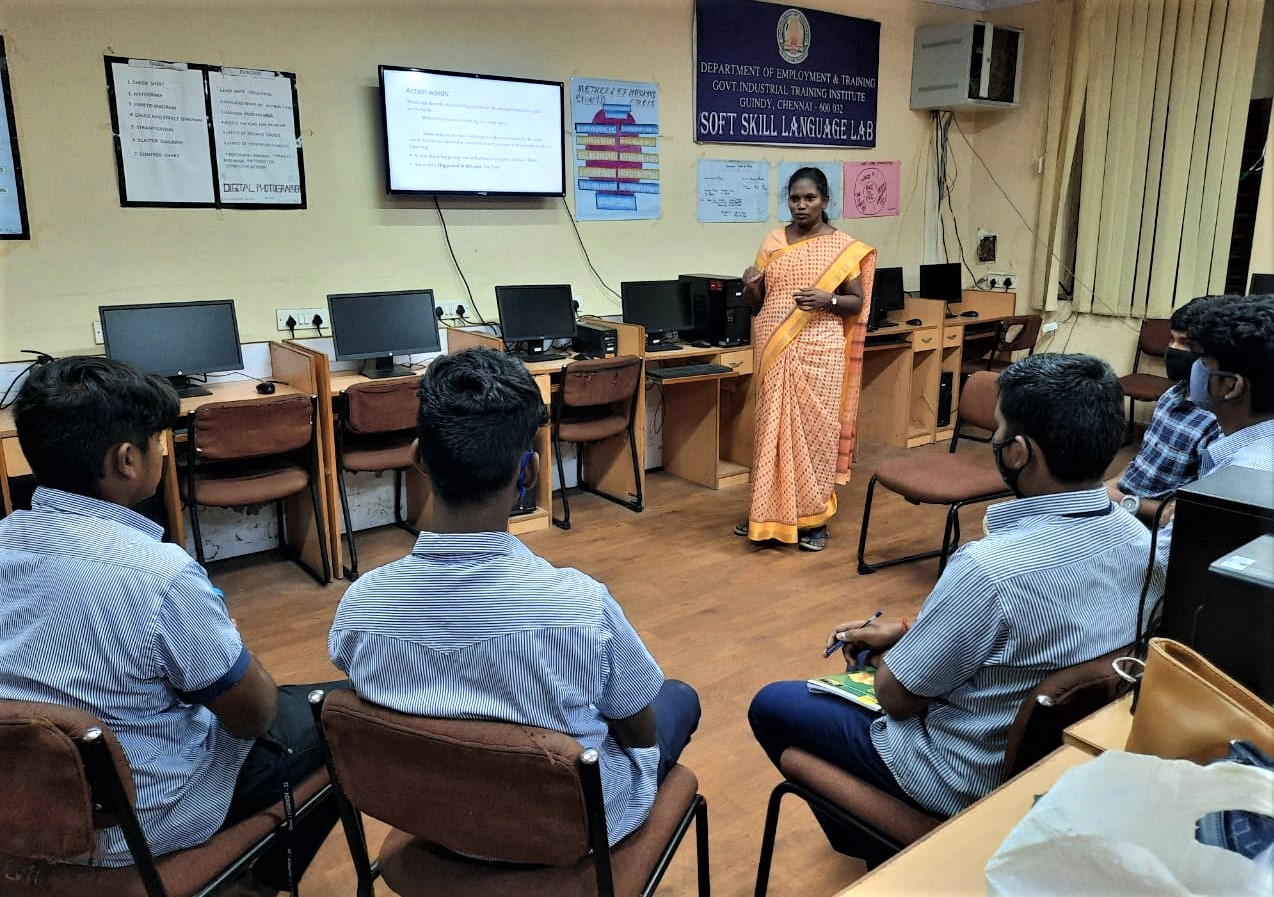
She believes she is quick to identify students who seem lost in class. Her classes are designed to be introspective and she tries to encourage students to question their own beliefs. Using her own personal examples, she encourages them to share stories of their life, so that they learn from each other. But the pandemic posed new challenges for Thabitha. She didn't anticipate the digital infrastructure she would need to quickly adapt to a virtual classroom. Poor network connections and no / limited access internet or smartphones were common. So she identified students with internet connectivity + smartphones and paired them with students in the same locality who didn't have these. That way they were able to share a device and attend online classes. “In online classes, I felt quite restricted as activity-based learning becomes a little difficult. However, I focused on keeping the classes interactive and used a Q&A format to ensure students don’t get bored,” she adds.
Every day Thabitha makes an effort to identify that little something: a spark, a talent, an aspiration that every student in her class has. “If I can help them believe that they can also achieve whatever they set their minds to, then I think I have prepared them for a successful future. Self-belief is the first step towards identifying and fulfilling your dreams. I hope my students will realize that and treat each other too with the same mutual respect,” she says.
GOING THE EXTRA MILE
Gopinath C., Govt. ITI - Madurai
Gopinath credits his foray into the teaching profession to his professor in college where he pursued a Bachelors in Business Administration. That professor sparked in him a renewed respect for the teaching profession. He understood that teachers can bring real change in their students and he wanted to be part of that journey.
So after completing his program, when Gopinath chanced upon an opportunity to become an ES trainer, he took it up without giving it a second thought. Now five years later, he considers it one of the best decisions of his life.
But Gopinath realized very early on that the mindset of students in an ITI was vastly different from his experiences in college. Initially he was very strict in his classes but students began to avoid him. “The first year students would still greet me but by the time they were in their second year, they wouldn’t as much as acknowledge my presence,” he adds. He met every batch of students only once a week and the Employability Skills syllabus was beginning to feel repetitive. “It took immense creativity to look at something new in the topic and convey it effectively,” he says.
With the help of some self-reflection and creative thinking, Gopinath realized that he could only be a good teacher if he changed his attitude towards his students. Most of his students came from a Tamil medium, and didn’t know the English alphabet, so teaching communicative English needed more than just focusing on speaking fluency.
Since his students were mostly learning trades which involved a lot of drawing, he got colourful, fun, three-dimensional images of the alphabet and asked students to draw it instead of rote learning it. “They really enjoyed drawing; and because they spent so much time drawing it, they remembered it,” he adds.
In another exercise, he screened videos of nursery rhymes that his students had likely learnt in their childhood. It triggered memories and many were able to recall most of them. Most of all, it helped reduce the fear of the English language amongst students.
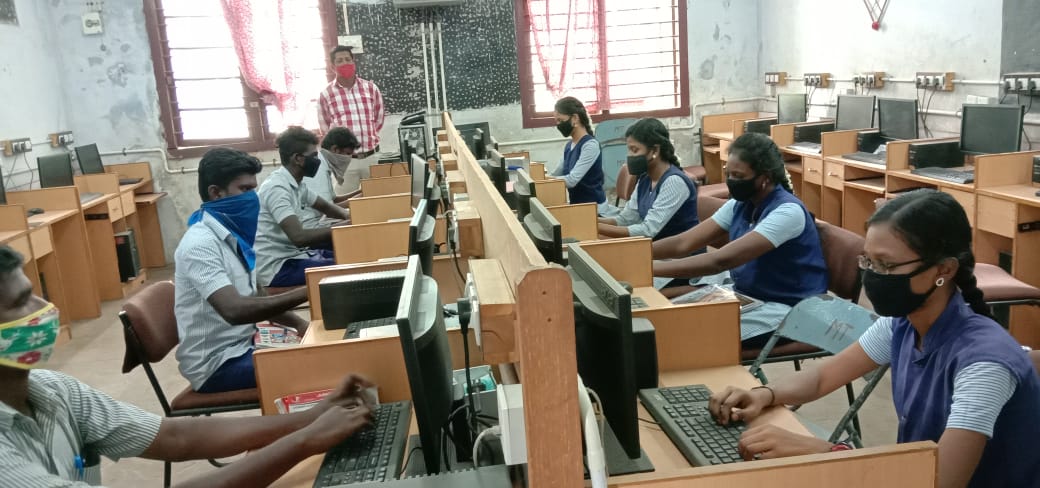
Gopinath soon realized a visual mode of teaching was the way forward. “If I had to teach them about propositions, I would ask them to draw a bus and then ask them to draw themselves standing on the bus. Thus introducing the proposition ‘on’,” says Gopinath.
As days went by, his classroom was filled with art-work made by students explaining parts of speech and basics of English grammar.
In 2020, while students with mobile phones and the internet were able to attend online classes, there were still many who lived in remote villages of Tamil Nadu without access to both. Gopinath sourced addresses of these students and began sending postcards to them. In the postcards, he wrote a basic overview about a concept in the Employability Skills curriculum that was taught in class and directed them to sources where they could get more information about the same topic. He wrote over 100 postcards during the course of the pandemic.
“There were 2-3 students in every trade who were completely cut off. I didn’t want them to miss out on all that the others were learning online. The postcards also verified the address for me, as those that did not reach the students came back,” he adds.
Gopinath wrote these postcards in English as he wanted his students to become comfortable reading English and understand formal communication. He didn’t receive any replies but once the classes opened in the ITI, students who received the postcards acknowledged it, “It felt nice when students came up to me and said they had received my postcard.” He hopes to continue to find new ways of reaching out to his students and dispel their fear of learning. “It is the teacher’s duty to ensure that a student remains curious. If that is lost, then what is left?” he asks.
SMART BOARDS FOR SMART CLASSES
Sharadha U., Govt. ITI - Muthupatti
Sharadha U, a trainer in Sivagangai district has been teaching for just over an year. Fresh out of college with an MBA degree, Sharadha admits to having initially felt daunted by teaching.
Sharadha has around 150 students across six trades under her tutelage and believes her undergraduate degree in psychology in helping her better understand the challenges her students face. She also received a lot of support from the ITI: older trainers shared strategies to engage students, the principal discussed challenges and successes in an open manner to help create better learning environments.
In terms of infrastructure, this ITI in Muthupatti has a language lab with an electronic whiteboard. The smart board allows students and trainers to project content on to the whiteboard and use a stylus to write on or move images etc. All in all a new tool that took regular classes to the next level. Trainers liked it, students were curious about it, so Sharadha realized that she could channelize this curiosity to encourage learning. She would group students and conduct assignments, quizzes, assessments; projecting tasks and questions on to the smart board. Students were very excited about these activities as they got to use the smart board.
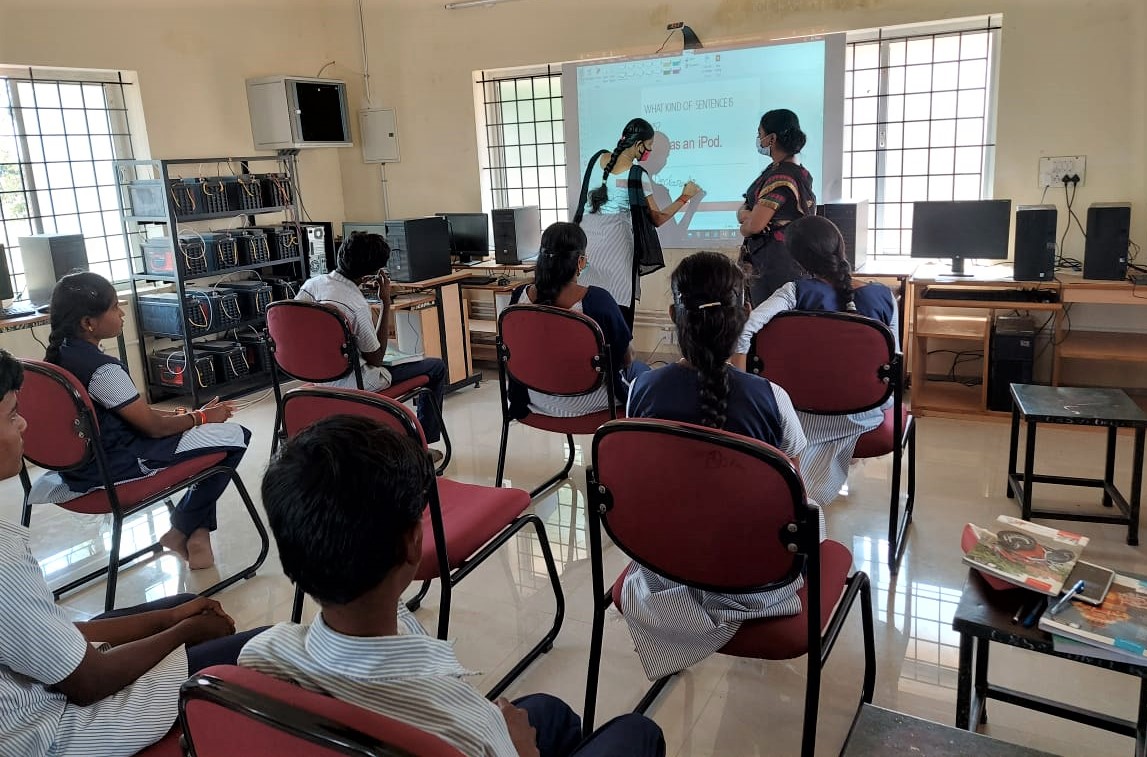
The smart board and a full-fledged computer lab offered a very modern classroom, allowing students to interact with new technology and the internet, thereby developing their digital literacy skills. Using parts of the e-content provided by the DET, and a mix of resources, books and the Quest App, Sharada simplified ways to learn different concepts.
With the pandemic, Sharadha suddenly found herself cut-off from all her students. “I didn’t have the contact numbers of any of my students. So, the first real challenge was to reconnect with them to begin online classes,” she adds.
Sharadha contacted other trainers and got mobile phone numbers of her students. “It took around a week to ensure that all the students knew how to login to an online session,” she says. Ensuring continuous participation of students in online classes was also one of the challenges. “I created PPTs for my online classes and circulated them separately to the students. To save time, I would have all the resources in one place and ready before beginning the online class,” says Sharadha.
However, she believes that online classes don’t provide the same level of interaction and engagement as physical classes. “There are issues with network and connectivity that make experience less seamless,” she adds.
For now Sharada is glad that physical classes have resumed at the ITI. “The pandemic pushed all of us to the edge and forced us to use technology in a more extensive way. I continue to use some of those learnings in physical classes too,” she says.
LEVERAGING TECHNOLOGY FOR LEARNING
Karthikeyan A., Govt. ITI - Pudukkottai
Though based in Trichy, Karthikeyan is credited for influencing students not only in Tamil Nadu but across India owing to his efforts at imparting critical information about the ITI ecosystem and Employability Skills curriculum.
“Students in ITIs have very little perspective on their trades. The main aim of my website was to provide them a broader understanding of what a trade will offer,” says Karthikeyan, as he talks about his website (www.iti50.com), where through a series of articles every month he provided students information about the ITI ecosystem.
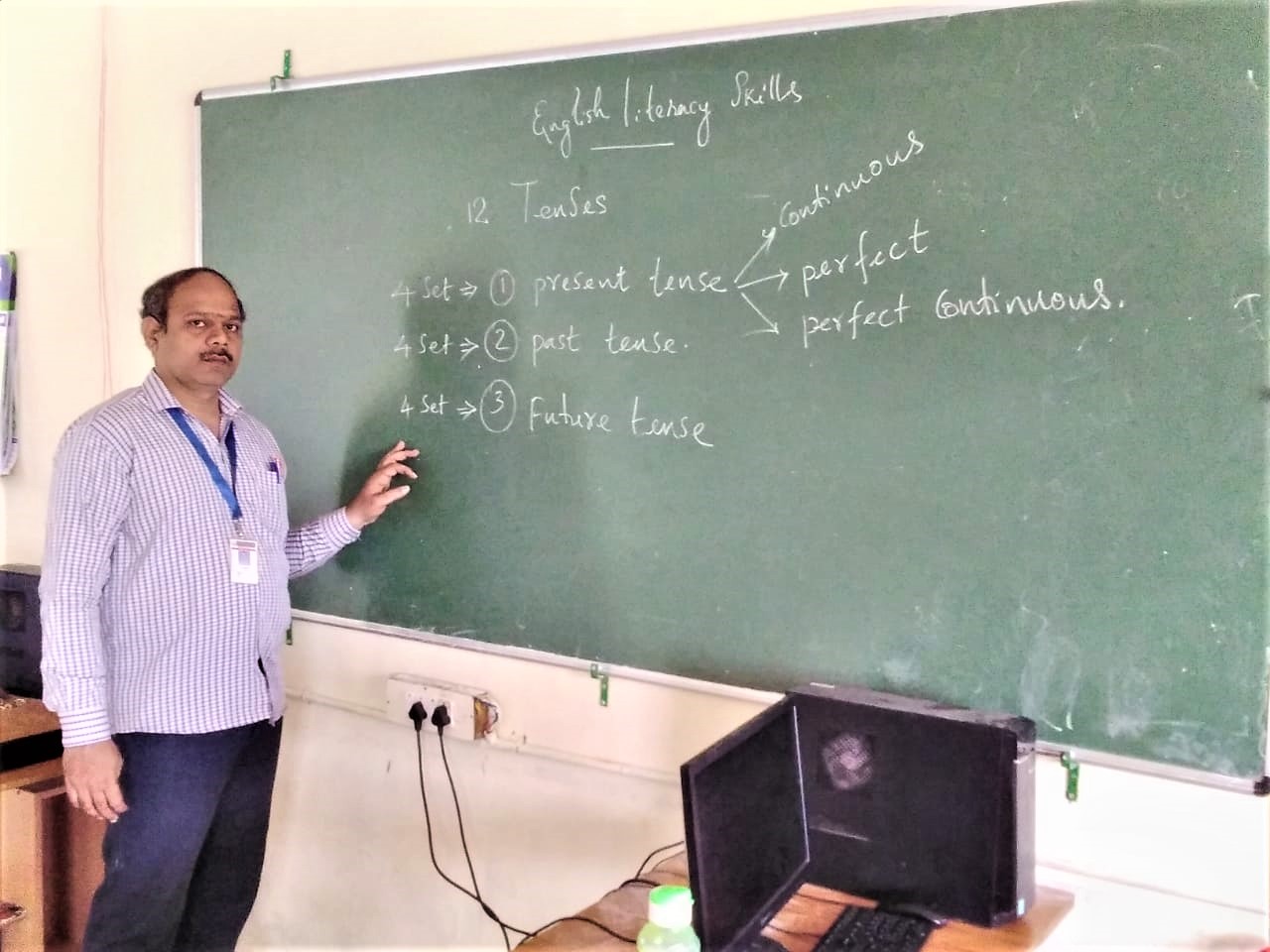
Karthikeyan, an MBA and M. Phil, already came with seven years of teaching experience before joining an ITI. “The teaching experience definitely helped but the real challenge was the student’s inability to perform basic tasks like switching on a computer, sending an email, or even operating a mouse” he says.
He said most time in his session would go by with students trying to figure out how to boot their systems. To overcome this, Karthikeyan began a blog in 2017. “I would write short blog posts related to the concepts I taught in class. So students who eventually got tech savvy over the course of the class could visit my blog and get short summaries of my classes,” he says.
Oddly enough not many students from Tamil Nadu read his blog. “Only about 25% of my students read my blog. But, I didn’t lose heart. It was also the time when technology was not welcomed inside classrooms. Students were discouraged from bringing smartphones to the class,” he adds.
But things gradually changed and Karthikeyan too upped his game by converting his blog into a website, “I built my website from scratch. I took HTML courses from online learning platforms and finally launched my website in 2018.” Within months of launching the website, he leveraged Google tools to bring 400 individual viewers for his website per day. “Analytics disclosed that most of the visitors to my website were from Assam, Meghalaya and Jharkhand,” he adds. He believes it was humbling to know that his small experiment to ensure students catch-up in class was helping students all across the country.
Today his intervention is used by ES trainers across Tamil Nadu to provide their students that additional support. Karthikeyan writes five articles per month despite his hectic schedule to ensure that ITI students continue to learn. In response to the pandemic, he started a YouTube channel titled ‘ITI Courses & Subjects’.
Karthikeyan currently has over 500 subscribers and uses PPTs to make short trade specific videos in Tamil. He again undertook online courses to develop video making skills. Karthikeyan is a strong proponent of self-learning and encourages his students too to use online resources to develop skills.
“Students love my classes because they are activity-based and student-centric" he says, and adds that he continues to use some of the activities learnt during trainer capacity building exercises. Amongst his other achievements was the recognition from the Dept. of Employment and Training, Tamil Nadu, for his efforts for reaching out to students -- he was one of the first ES trainers to conduct online sessions for the government, and more than 500 students across Tamil Nadu participated in these sessions.
Karthikeyan hopes to continue to learn and inspire young people to take control of their lives. “I want every young person to remember that learning is a lifelong process and each of them has the potential to fulfill their dreams,” he adds.
BRINGING BEHAVIOURAL CHANGE
A. Vairamani, Govt. ITI - Arupukottai
A. Vairamani, an MBA graduate, joined the Govt. ITI in Arupukottai as an ES trainer in 2015. Over the past five years Vairamani has seen numerous changes -- both in the ITI and his own approach to teaching.
“Most of the boys in the ITI came from very poor backgrounds and smoked and ate tobacco,” he says as he talks about the challenges he faced as he started out. To address this issue, Vairamani contacted local stores near the ITI urging them to not sell cigarettes or tobacco to the students. While this did change things, it also alienated Vairamani from his students. “They now began to be weary of me. They perceived me as someone very strict and hard to approach,” he adds.
He realized that to be able to connect to the students, ease their apprehensions about him, he had to first understand them better. To build a rapport with them, Vairamani started interacting with the students even after the class. The employability skills session was usually followed by the PT class, and so he made it a point to interact with students outside of his own session, in between classes and in the PT class.
It took a while but over a period of time, students got to know him better, began trusting him, spoke of their concerns with him more openly, and understood them as well. “From a trainer, I became a mentor. It feels nice to be involved in the journeys of my students,” he adds.
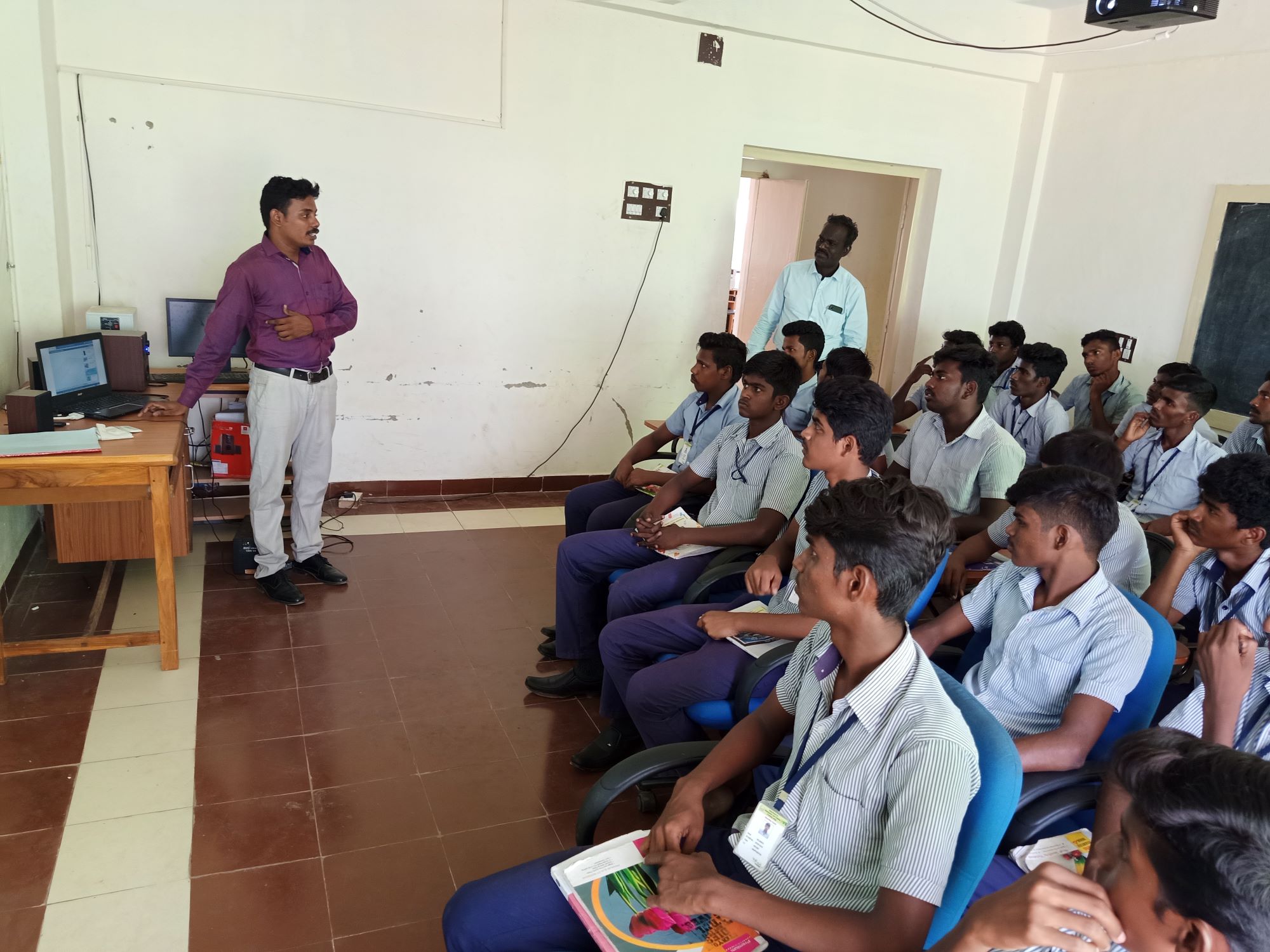
Vairamani believes the blended learning model helped his transformation as a trainer. It allowed him to help learners with varied learning styles. Even during the pandemic, Vairamani continued reaching out to his students and finding ways to support them. He used his personal Facebook account to conduct online classes. And since not everyone in his class had access to devices for long periods of time, he designed classes that were no longer than 30 mins. The short-duration of the class helped students get permission to use their shared phones, and focus well on the topics covered.
Vairamani hopes to continue finding more innovative ways to reach out to his students. “They are young people, full of potential. It is necessary for someone to believe in their abilities. It is important for trainers to realize their role in helping young people find themselves,” he adds.
In the weeks to come, we will continue to introduce to you other trainers who have gone the extra mile and promoted meaningful, resourceful and safe use of technology for ITI students.
We are proud to have been part of their journeys and to have had the opportunity to support them in whatever ways fit them best.
K. Veera Raghava Rao, IAS
Director, Depart of Employment & Training, Tamil NaduA trainer can play an important role in imparting employability skills to trainees and thereby help them become industry-ready. This partnership has helped us transform the mindset of both trainers and trainees and supported them to contribute to nation building. I congratulate and appreciate Cisco and Quest Alliance for this initiative.